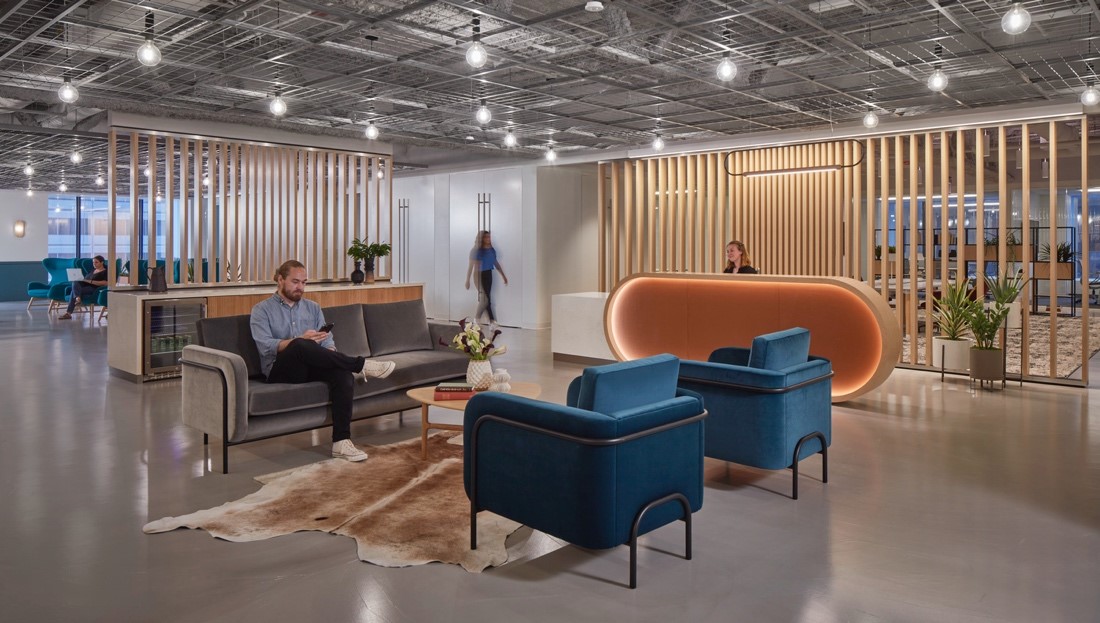
Leonora Georgeoglou is a National Workplace Sector Leader at HED. In her more than 20 years in the A/E industry, her career has ranged from overseeing the technical details of multi-floor office high-rises to leading executive and facilities teams through visioning sessions for hundreds of millions of dollars in design work. Throughout her career, she has developed a strong reputation for leadership, research, and advocacy for the advancement of architecture as a discipline, as well as for valuing sustainable, responsible solutions that respect client needs and the environment.
Georgeoglou’s passion for integrated design stems from her varied experience with demanding projects, where minor details can result in massive savings to schedule, cost, and space performance, as well as the user collaboration that’s paramount to innovation.
Believing that design excellence stems from not accolades or aesthetics, but tangible, measurable, positive effects for the client and community, Georgeoglou uses design to successfully integrate interiors with architecture to the benefit of users and clients. Accordingly, her work covers a wide range of project and client types — from workplaces to senior housing to higher education.
Ultimately, Georgeoglou brings not only deep design expertise, but also considerable experience in space planning and programming; interior architectural design; lighting design; and furniture and finish solutions.
Q. What is your personal approach to commercial interior design?
My design approach is one that balances sustainability, adaptability and client needs. I have a passion for integrating interiors with architecture and using evidence-based design in my projects. I bring clients’ goals to life through visioning sessions, where I seek to deeply understand the culture and values of the company and team who will be using the space. I reflect that in my designs through the use of local materials, art, lighting, furniture and finishes.
Q. How did the COVID-19 pandemic change the office interior design sector?
Most of what we saw being implemented during the pandemic — such as distancing; shutting down kitchens and shared amenities; and see-through barriers — didn’t last. Hybrid work is what has taken hold and is the driving force impacting the offices of tomorrow. Despite some organizations pushing for a full return to office, 74% of U.S. companies are using or plan to implement a permanent hybrid work model. Employees crave flexibility and offices that support collaboration and a new way of working. This has radically shifted how we envision our experience of the workplace and what it should include.
Q. What workplace design trends can we expect to see more of in 2023?
A focus on user wellness (mental, physical, emotional) will be front and center this year. We’ll see more amenities, spaces, programs, and materials that enhance comfort, security and health. With this focus on wellness comes a stronger emphasis on healthy materials that support user health. This includes everything from interior finishes and flooring to furniture and insulation. These spaces will also create a sense of belonging that encourages authenticity and creativity.
Companies will downsize square footage and put more emphasis on the quality and purposefulness of the space that remains. Workplaces will continue to become about a planned work experience, and the home office will be the realm of productivity. This will include greater investment in amenities that are thoughtful and connect to culture. The savviest organizations will design programs and events to take full advantage of their spaces as enrichers of culture.
Room design will center [on] technology and we’ll see more purposeful technology suites. These suites will better support hybrid work with shifting displays that transform the in-office and virtual experience and allow for constant video/audio connectivity through the office by camera. The technology that is present will emphasize mobility — including laptops, mobile devices and high-speed Wi-Fi mesh networks — over hardlines and collaboration. This blending of technology and design will help employees better collaborate while being in different places.
Lastly, we’ll see more evidence-based design services that leverage hard data, such as employee utilization; productivity drivers; effectiveness and quality; culture building; etc.
Q. Are there any trends that you expect to see declining in the next few years? Why?
I predict we’ll continue to see a decline in private offices for most roles. The home office is now the private office and commercial workplaces are the spaces for community and collaboration. We’ll also see a decrease in fully open offices and design strategies that center [around] personal workstations. The expectation that everyone will be in the office at the same time focusing on individual work is eroding. Now, when we come together, we will do it to be together.
Q. What are some of the best home office decorating tips you can give us?
Some of the best practices that govern corporate office design can be implemented in the home. Without that liminal space of a commute, it’s important to consider how you’ll create separation and balance between your home office and the rest of your home. If it’s possible, the home office should be a room that you can walk away from and create mental and physical separation and protect your work/life balance. If it has a door you can close, close it at the end of the day. If you don’t have the luxury of a room dedicated to your home office, then hopefully you’re working from a laptop you can at least close in a drawer and keep out of sight when your day ends. If possible, choose a room with a lot of natural light. Daylight exposure over the course of the day stabilizes your circadian rhythms, improves sleep and is also shown to improve focus and lift your mood.
As for decor, I’d encourage readers to invest in physical comfort. Spend time finding a chair that is comfortable and fits your body. Manufacturers design office chairs to be close to one-size-fits-all and adjustable, meaning women often end up with chairs that are too large. Some product lines have sizes, but if you’re on the bigger or smaller end of that one-size-fits-all spectrum, you might not be able to adjust to comfort. Standing desks are great, and I recommend furniture that can adapt and flex to allow for standing. But, first and foremost, invest in a chair that fits you. If you’ve still got a budget beyond the standing desk and chair, invest in a rug and padded mat for under your feet when you’re standing. Prioritize comfort and ergonomics.
When your physical comfort is taken care of, I recommend incorporating natural elements for the wellness benefits. Living plants, colors, and patterns that mimic nature and decor that utilizes natural materials — like cork, wood, hemp and bamboo — are great places to start.
Q. Are there any other insights you’d like to share?
Companies that are trying to attract talent back to the office shouldn’t try to compete with the home office. Attempting to compete with someone’s home for comfort and productivity is a losing battle. Instead, organizations will benefit from creating spaces that enhance the few days of work being done in the office. Spaces that offer community, creativity, technology and ample opportunities for collaboration. Those are the corporate spaces that will stand out in the future of work.
Interested in being interviewed for our Expert Insights series? Feel free to reach out to us at [email protected] or check out other articles from our series here.









